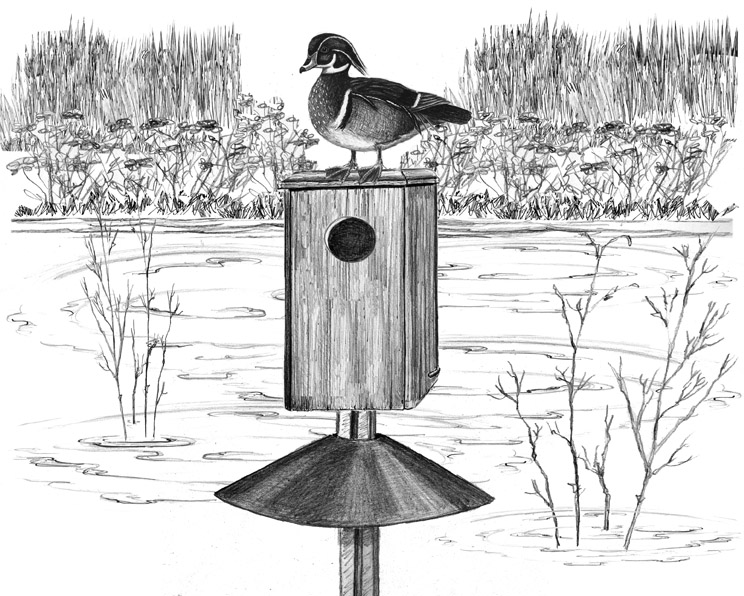
Dear Bird Folks,
I’m thinking about putting out a nest box for Wood Ducks. Do you have any suggestions?
– Carole, W. Barnstable, MA
Yes, I do, Carole,
I certainly do have a suggestion…get going. Here in the north, Wood Ducks start laying their eggs in April, which, if my calendar is correct, is right now. Luckily, the IRS has just extended this year’s tax deadline. Why is that important? It means you can take a break from preparing your taxes (and, if you’re like me, trying to figure out how you can write off the cost of your Netflix account). Instead, you can use the extra time to put up a Wood Duck box, which I believe is the main reason the IRS gave us the extension in the first place.
Some people claim that the Painted Bunting is the most colorful bird in North America, but I would argue that the title belongs to the Wood Duck. (Sorry, cardinals. Get over yourselves.) The drakes are stunning, looking like a bird created when Sherwin-Williams and Mother Nature tried to incorporate every known color into one creature. The colors include – but not limited to – white, blue, red, black, purple, green, brown, rose carmethene and alizarin crimson. I could go on, but I’m only allowed 900 words.
You might think a bird as beautiful as this would be cherished and protected, but nope. Instead of cherishing them, we once shot as many as we could find. Naturalists assumed the Wood Duck would soon be one of the first North American species to become extinct. Fortunately, however, Wood Ducks love deep, dark swamps, and enough birds were able to survive in these remote locations until protective laws could be enacted. After we stopped shooting them, the birds ran into another problem, loggers. As their name indicates, Wood Ducks are tree cavity nesters and when the trees came down for farming, paper, lumber and to a lesser extent, nickels, the birds struggled to find adequate nesting sites. Better land management helped reestablish our forests, but then yet another issue arose, DDT.
It’s well known (now) that DDT caused eagle eggs to soften and break before hatching, but this nasty substance also did something else: it killed insects. That last piece of information is not news, as killing insects is what DDT was invented for. But even though insects are annoying to us, they are an essential part of the ecosystem. For the first few weeks of their lives, young woodys feast exclusively on aquatic insects. When DDT arrived, those insects became scarce, resulting in a lot of baby ducks going to bed hungry. Happily, those dark days are gone. Shooting is now regulated, DDT is banned, the trees are back…and so are the Wood Ducks. 🙂
When most folks think of birdhouses, they think of bluebirds but an array of other birds, including martins, flycatchers, owls and some ducks will also use properly designed boxes. But unlike a bluebird house, which is fairly small, inexpensive and can be set out in anyone’s yard, Wood Duck boxes are large and a little pricey, and they also require specific habitat. Wood Ducks, as you might imagine, love water, and it has to be fresh. You aren’t likely to find a Wood Duck in salt water. (They’ve heard about the sharks.) They also like things quiet, thick and swampy. You’ll have a much better chance of attracting them to a pond with restricted access and lots of growth around the edges. Ponds with swimming areas, or that are encircled by public trails are not Wood Duck friendly, or any other kind of wildlife friendly.
Screech-owls prefer their boxes to be hung at least ten feet high, but woodys aren’t as fussy. A box placed roughly head high is fine with them (your head, not the duck’s). According to the Wood Duck Society (yes, it’s a real thing), your best bet is to set your box on a post that’s either in water or facing water, with a predator guard on the post. They discourage nailing a box to a tree. If do that, you may end up with a raccoon “enjoying” the ducks as much as you do. The box should also have at least four inches of wood chips on the bottom…and it should be put up today. Your taxes can wait.
Here’s a nice story: I have a customer in South Orleans, who each spring has several boxes of nesting Wood Ducks. (She probably should be writing this column.) The first time we met, she invited us to her house to see her ducks. Several employees and I, plus a sketchy sales rep who just happened to be in the store at the time, drove over. Wood Ducks are shy so the best place to see them was from the lady’s living room. As we all stood at the window, waiting for the ducks to arrive, she announced that she had to go to the post office before it closed, but we could stay as long as we wanted. What? At this point, we didn’t even know this woman’s name, yet she left several strange birders, plus a sketchy sales rep, alone in her house, just so we could see Wood Ducks. Good ol’ Cape Cod. That doesn’t happen in many other places. (Although we weren’t totally alone. The lady left her humorless cat to keep an eye on us, so we didn’t dare do anything wrong.)
The keys to attracting nesting Wood Ducks, Carole, include a box on a post with a predator guard, located near a quiet freshwater pond or swamp with thick vegetation along the shore. Also, routine maintenance to replace the wood chips is important. After that, just keep your fingers crossed. Finally, let me know if you try to write off your Netflix charges. I’m thinking about doing it myself, but I want you to go first.